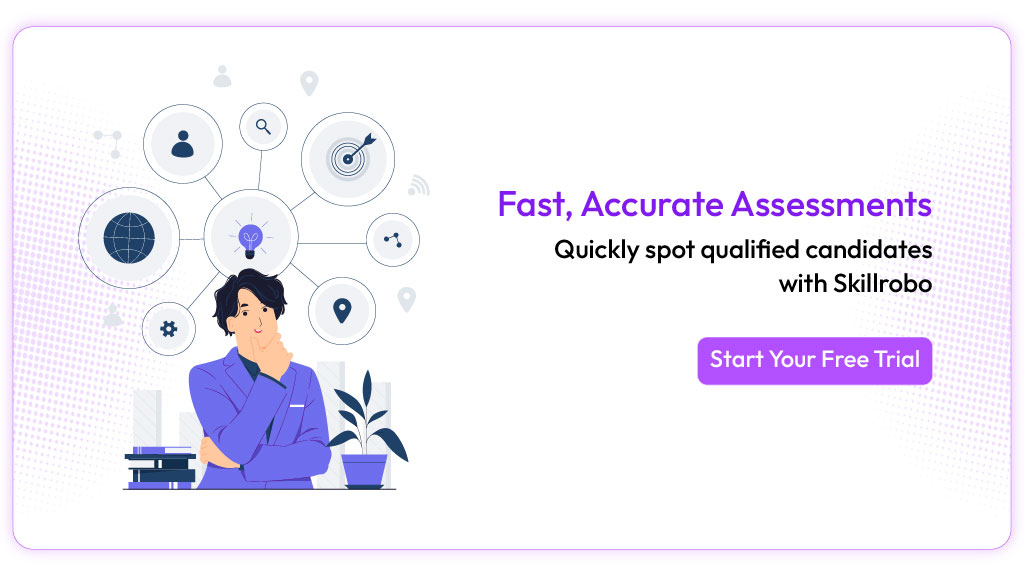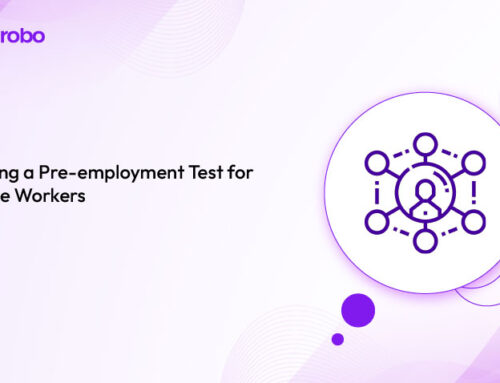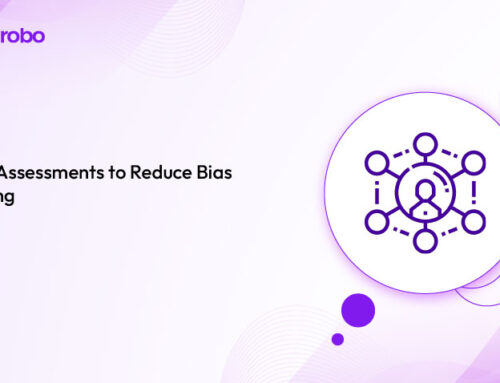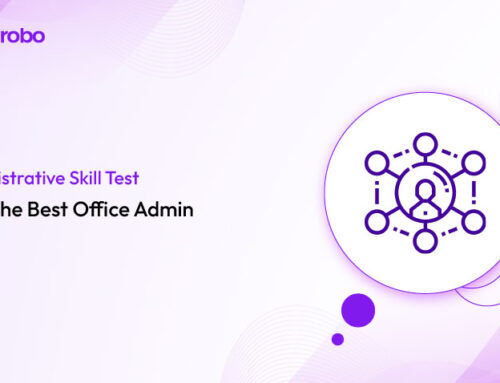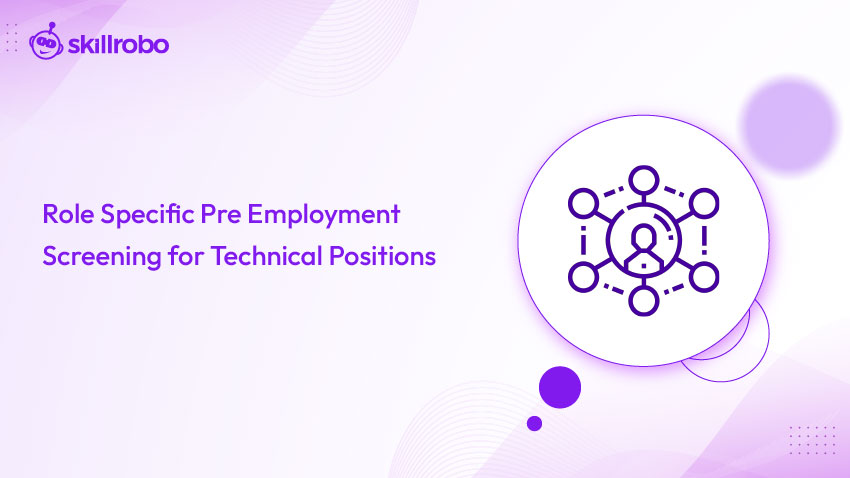
Key Takeaways
- Role-specific assessments ensure technical hires possess the necessary skills, reducing mismatches and boosting job performance.
- Cognitive and behavioral evaluations uncover problem-solving abilities and team fit, which are critical for success in technical roles.
- AI-driven screening tools streamline hiring by generating precise, job-relevant questions and delivering real-time analytics.
- Proctoring enhances fairness in technical assessments, maintaining integrity and trust in remote or high-stakes evaluations.
Precision Hiring: Screening Technical Talent Effectively
Hiring for technical positions—software developers, data scientists, cybersecurity analysts—presents unique challenges for HR professionals and hiring managers. These roles demand precise skills, from coding proficiency to analytical thinking, and finding candidates who meet exact requirements can feel like searching for a needle in a haystack. Traditional resume reviews and interviews often fall short, missing critical insights into a candidate’s practical abilities or problem-solving mindset. Role-specific pre-employment screening changes the game, offering a targeted approach to identifying top technical talent efficiently and objectively.
The stakes are high: a single mis-hire in a technical role can cost companies thousands in lost productivity, onboarding, and rehiring efforts. Organizations like Google and Amazon have long relied on structured assessments to filter candidates, proving the value of precision in talent acquisition. By focusing on job-relevant competencies, role-specific screening ensures hires not only meet technical demands but also thrive in dynamic, collaborative environments. In this blog, we’ll explore how to implement role-specific pre-employment screening for technical positions, with actionable strategies to streamline your hiring process.
Why Role-Specific Screening Matters for Technical Roles
Technical positions require a blend of hard and soft skills. Generic screening methods often fail to capture this complexity, leading to hires who may excel on paper but struggle on the job. Role-specific screening addresses this gap by tailoring assessments to the unique demands of each position, ensuring candidates are evaluated on the skills that matter most.
Data backs this up: a study by the Aberdeen Group found that companies using role-specific assessments report 36% higher retention rates for technical hires.
This precision saves time and resources while building teams capable of driving innovation. For instance, firms like Microsoft use targeted evaluations to pinpoint candidates who can handle real-world challenges, from debugging code to designing scalable systems. HR teams can make confident, data-driven decisions by aligning screening with job requirements.
Matching Skills to Job Demands
Every technical role has distinct needs. A front-end developer must master JavaScript frameworks, while a data analyst needs expertise in statistical modeling. Role-specific tools, like coding aptitude evaluations, allow hiring managers to test candidates on relevant technologies, ensuring a precise skills match.
Reducing Bias in Selection
Subjective screening can favor candidates with polished resumes over those with genuine talent. Role-specific assessments level the playing field, focusing on measurable abilities rather than credentials. This approach aligns with fair hiring practices, promoting diversity and inclusion in technical teams.
Benefits of Role-Specific Technical Screening
The impact of role-specific screening extends beyond filling open positions—it strengthens your entire talent pipeline. By focusing on precision and fairness, this approach delivers measurable advantages that resonate across the organization. Companies like Salesforce have leveraged targeted assessments to build high-performing technical teams, showcasing the value of this strategy.
1. Higher Hire Quality
Generic screening risks missing niche skills—like a machine learning expert’s TensorFlow mastery. Role-specific tests ensure candidates excel in job-critical tasks, delivering hires who contribute immediately. A cloud provider might confirm Azure skills, avoiding hires needing extensive retraining.
2. Faster Time-to-Hire
Manual resume reviews bog down technical hiring—automated, role-aligned tests filter unqualified applicants fast. A startup can screen developers in days, not weeks, focusing on top talent and shrinking time-to-fill, critical when projects demand swift staffing.
3. Improved Team Fit
Technical roles rely on teamwork—combining skills and behavioral tests ensure hires mesh culturally. A data team gains an analyst who collaborates well, boosting retention and productivity by aligning individual strengths with collective goals seamlessly over time.
Key Components of Effective Technical Screening
A robust screening process for technical roles goes beyond basic skills tests—it integrates multiple evaluation types to assess candidates holistically. From coding challenges to behavioral insights, each component plays a critical role in identifying hires who can excel in high-stakes environments. The goal is to create a seamless workflow that delivers actionable data without overwhelming your team.
Companies have set a benchmark by combining technical assessments with analytics to streamline hiring. Their approach highlights the importance of structure and specificity, ensuring candidates are tested on real-world scenarios they’ll face on the job. Let’s break down the essential elements that make technical screening effective.
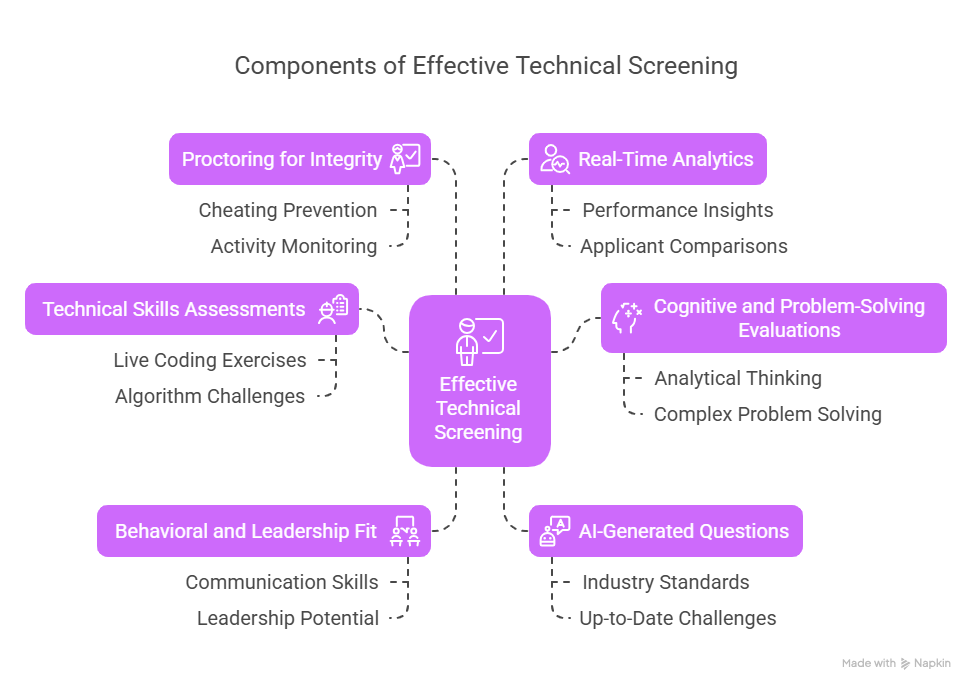
1. Technical Skills Assessments
The heart of technical screening lies in evaluating hands-on skills—can a candidate write code, configure systems, or analyze data effectively? These assessments range from live coding exercises to algorithm challenges, designed to mirror the tasks hires will tackle. For a software engineer, this might mean building a REST API in 30 minutes; for a network admin, it could involve setting up a VLAN.
Tools for evaluating candidate skills offer flexibility, letting recruiters tailor questions to roles like full-stack development or IT support. A fintech company, for instance, might test a developer on secure payment processing, ensuring they can handle sensitive data. These tests provide concrete evidence of ability, cutting through resume hype and confirming hires can deliver results in real-world technical contexts.
2. Cognitive and Problem-Solving Evaluations
Technical expertise alone isn’t enough—IT roles demand sharp reasoning to solve unexpected challenges, like diagnosing a system crash or optimizing a slow database. Cognitive assessments measure how candidates think through problems, testing skills like logical deduction or pattern recognition. For a data scientist, this might involve analyzing a dataset to spot trends; for a systems engineer, it could mean prioritizing fixes during an outage.
These evaluations reveal a candidate’s ability to adapt and innovate—crucial in fast-evolving tech fields. Assessments for cognitive abilities include puzzles or scenarios that test analytical depth, ensuring hires can handle the intellectual rigor of roles like machine learning or infrastructure design. A logistics firm might use this to find an analyst who can streamline supply chain algorithms, proving cognitive fit is as vital as technical know-how.
3. Behavioral and Leadership Fit
Technical teams don’t operate in silos—collaboration, communication, and adaptability are essential, especially for senior roles. Behavioral assessments explore how candidates interact, manage stress or lead projects. A DevOps engineer needs to coordinate with developers, while a tech lead must inspire and guide. These traits can make or break team success.
Competency assessments evaluate soft skills through scenarios—like resolving a team conflict over project priorities—ensuring hires fit culturally and lead effectively. A startup hiring a CTO, for example, might test strategic decision-making under pressure, confirming the candidate can steer technical vision while fostering collaboration. This holistic view ensures technical hires align with both job demands and team dynamics.
4. AI-Generated Questions
Manually crafting test questions is labor-intensive and risks missing industry shifts—like new frameworks or security protocols. AI solves this by generating precise, role-aligned questions that stay current. Seyarc AI on Skillrobo focuses on question creation, producing challenges like designing a microservices architecture or securing a cloud instance, tailored to roles from web development to cybersecurity.
This automation saves time while ensuring relevance—a gaming company might test Unity skills for a developer, while a bank assesses fraud detection algorithms. By reflecting real-world demands, AI-driven questions keep assessments cutting-edge, giving recruiters confidence that candidates are evaluated on the latest technical standards and practices.
5. Proctoring for Integrity
Remote hiring amplifies risks like cheating or impersonation, especially for technical roles where skills must be unquestionable. Automated proctoring maintains test integrity by monitoring activity—tracking screen-sharing, eye movements, or external help. Seyarc AI’s integration flags irregularities, similar to platforms like HackerRank, ensuring results are authentic.
For a cybersecurity hire, where trust is paramount, proctoring confirms expertise in tasks like penetration testing isn’t faked. This rigor protects hiring quality, particularly in distributed or high-stakes settings, giving managers reliable data to base decisions on, free from doubts about candidate honesty.
6. Real-Time Analytics
Sifting through test results manually slows hiring and risks missing top talent. Real-time analytics deliver instant insights—coding accuracy, problem-solving speed, or behavioral scores—streamlining decision-making. Skillrobo’s reporting tools rank candidates and highlight strengths, like a developer’s efficiency or an analyst’s precision, across large pools.
A tech firm hiring dozens of engineers can compare applicants instantly, focusing on standouts for interviews. This data-driven approach cuts time-to-hire and ensures selections are based on performance, not gut feel, making it a game-changer for scaling technical recruitment efficiently.
Steps to Implement Role-Specific Screening
Adopting role-specific screening requires a thoughtful approach to ensure alignment with your hiring goals. Whether you’re filling a single developer role or building an engineering team, a clear roadmap helps integrate assessments seamlessly. The process isn’t about replacing human judgment—it’s about enhancing it with objective, actionable insights.
Organizations like IBM have refined their technical hiring by blending assessments with existing workflows, a model HR teams can emulate. Below, we outline practical steps to implement role-specific screening, grounded in best practices from the recruitment space.
Step 1 – Identify Role Requirements
Begin by mapping out each role’s must-have skills and traits. A cybersecurity analyst needs threat detection expertise and risk assessment skills, while a DevOps engineer requires CI/CD pipeline knowledge and automation experience. Engage team leads to pinpoint priorities—like scalability for architects or debugging for support.
This clarity shapes your assessments. A healthcare company might focus on HIPAA compliance for IT hires, ensuring tests reflect regulatory needs. By defining these requirements, you set a foundation for screening that targets the exact competencies your technical roles demand, avoiding vague or irrelevant evaluations.
Step 2 – Select Tailored Tools
Not all platforms fit every technical role—choose ones with flexibility and depth. Evaluations for technical competencies on Skillrobo support diverse needs, from programming tests for developers to system diagnostics for IT admins. Look for customization options to match your job profiles.
A startup might prioritize rapid coding tests, while an enterprise needs robust analytics for volume hiring. Selecting the right tool ensures assessments align with your technical landscape, delivering precise data without overcomplicating the process, and integrating smoothly with your hiring strategy.
Step 3 – Design Realistic Scenarios
Tests should reflect the challenges hires will face—generic questions miss the mark. For a back-end developer, include a database optimization task; for a network engineer, simulate a routing issue. Skillrobo offers AI-generated questions, ensuring scenarios stay relevant.
A retailer hiring IT support might test ticket resolution speed, mimicking peak-season demands. Realistic scenarios validate skills in context, giving recruiters confidence that candidates can handle the specific technical hurdles their roles present, and bridging the gap between assessment and performance.
Step 4 – Integrate with Your ATS
Fragmented workflows waste time—integrate screening with your applicant tracking system (ATS) for efficiency. Skillrobo’s compatibility with other tools ensures candidate data flows from tests to interviews seamlessly, tracking scores alongside resumes and notes.
For a large tech firm, this means managing hundreds of applicants without losing insights—like a developer’s test ranking. Integration keeps the process cohesive, reducing manual effort and ensuring technical screening enhances, rather than disrupts, your existing hiring pipeline effectively.
Step 5 – Pilot and Refine
No process is perfect out of the gate—pilot your screening with a few roles to test its impact. Did a systems analyst hire Excel after a network test? Analyze outcomes and gather feedback from managers or candidates to spot weaknesses, like overly tough questions.
A pilot might reveal a need for shorter coding challenges or clearer instructions. Refine based on results—tweak difficulty, adjust criteria, or expand analytics—ensuring your screening evolves into a reliable tool for technical hiring that delivers consistent, high-quality hires.
Conclusion
Role-specific pre-employment screening for technical positions empowers HR professionals to hire precisely and confidently. By targeting job-relevant skills, cognitive abilities, and behavioral fit, this approach ensures candidates are equipped to excel. Skillrobo simplifies the process with role-specific assessments, AI-generated questions, proctoring, and real-time analytics—features designed to streamline technical hiring. Ready to build a standout tech team?
Sign up for Skillrobo today and discover how tailored screening transforms your recruitment strategy.

